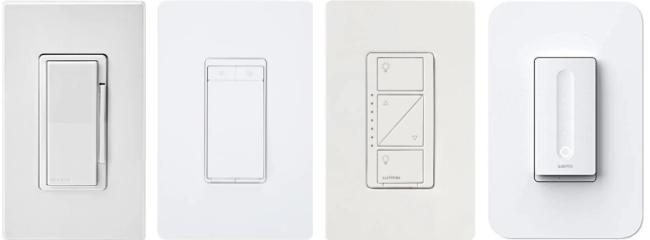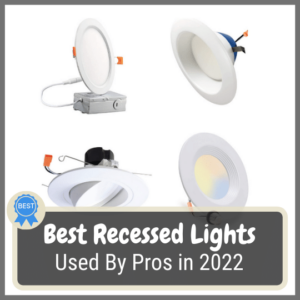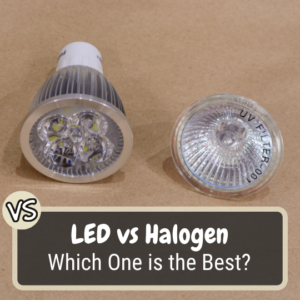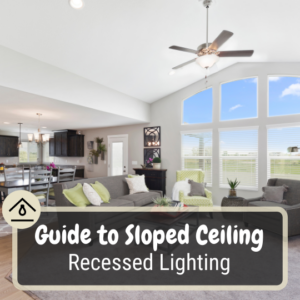While the best dimmer switch for recessed lighting is a matter of preference, you may not want to choose one based on appearance alone. Each dimmer style works differently, so it’s worth giving it some thought.
Modern Dimmers
The four most common styles of dimmers are:
- Slider dimmer with switch
- Slider dimmer without switch
- Tap dimmer
- Smart or Connected dimmer
All four styles fit the standard Decora style (Rectangular) switch plates.
Let’s take a look at the differences between them, and compare the pros and cons of each style.
Slider Dimmer with a Switch

Slider Dimmers with a Switch are probably the most common type of dimmer you’ll find. They have a vertical or horizontal on/off switch, combined with a lever that slides up and down to adjust the brightness of the lights.
Pros
- They closely match the modern Decora (rectangle) style switches.
- The dimmer adjustment is simple and intuitive – raise the slider to brighten the lights, and lower it to dim the lights.
- Very durable.
- You can preset the brightness lever, and then turn the lights on or off like a regular switch.
Cons
- Can only install at one end of a 3-way circuit.
Slide Dimmer without a Switch
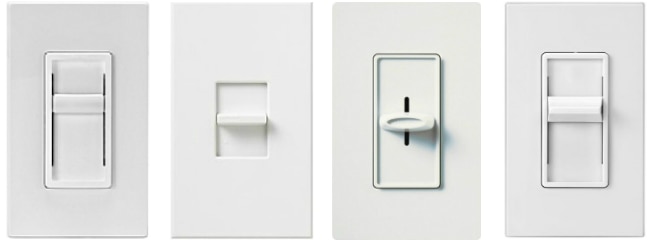
Slide Dimmers without a switch, aka slide-to-off dimmers, do not have an on/off switch. To turn the lights on, you slide the dimmer up to the desired light level. To turn the lights off, you slide the lever all the way down.
Pros
- Very easy to use.
- Typically cost less than other dimmers.
- Great if you like to adjust the brightness each time you turn on the lights.
Cons
- No presetting. Because you slide the dimmer all the way down to turn the lights off, you have to set the brightness each time you turn them on.
- Lights can be accidentally left on at a very low level because the dimmer was not pushed all the way down to off.
- Will only work in single-pole circuits. Cannot use with in a 3-way circuit.
Tap Dimmer
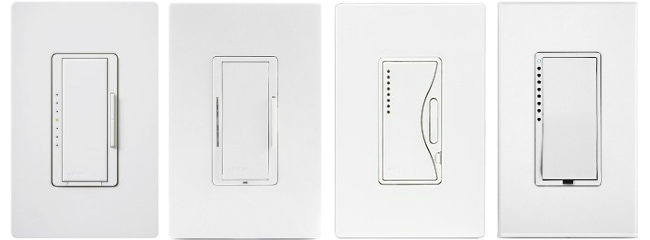
Tap dimmers are typically flat with a large rectangle-shaped button that you tap to turn the lights on or off, combined with a lever or buttons used to adjust the brightness. Most have LED indicator lights that display the light level.
Pros
- Unlike standard dimmers, electronic dimmers can be installed at both control points in a 3-way circuit. This is especially useful to control recessed lighting above staircases where you want to be able to adjust the brightness from the top and bottom of the stairs. If you have a standard dimmer installed in a 3-way circuit, the dimmer goes at one end, and an on/off switch remains at the other. When you turn on the lights from the switch, they will only be as bright as the dimmer is adjusted to at the other end.
- They have a modern, streamlined appearance that matches Decora style switches.
- Most have adjustable preset levels.
- Some have adjustable fade on/off rates that adds drama to the lighting.
Cons
- They have a slight learning curve that can be frustrating to some.
- Their advanced electronics mean they typically cost more than slide dimmers.
- Some require a neutral wire in the switch box which can be a problem if your circuit is not wired that way.
Smart or Connected Dimmer
Smart dimmers are Tap dimmer switches that have added wireless connectivity. Their capabilities range from simple dimming to sophisticated scenes and automation control. Smart dimmers are usually setup and programmed using a smartphone app.
Pros
- They work as a normal wired dimmer switches, but also have wireless connectivity that allows you to control them from from other devices such as a smartphone or smart devices like Alexa or Google Home.
- Some smart dimmers can be linked together to allow you to control groups of lights from a single location, or control one set of lights from several locations.
- Most have adjustable preset levels.
- Some have wireless companion dimmers that can be used to create wireless 3-way circuits without running any new cables.
- Some versions are available with occupancy sensors that can turn lights on or off automatically.
Cons
- They require some setup and programming to connect them to your home’s network which can be frustrating to some.
- Their advanced electronics mean they typically cost more than regular dimmers.
- Some require a neutral wire in the switch box which can be a problem if your circuit is not wired that way.
How to Choose the Best Dimmer
First, consider whether you would benefit from controlling the lights using a smartphone or your voice. If not, rule out using a smart dimmer for that room.
Next, are the lights controlled from more than one location (a 3-way circuit)? If so, rule out the Slide-to-off dimmer style because they can only be used in single-pole circuits.

